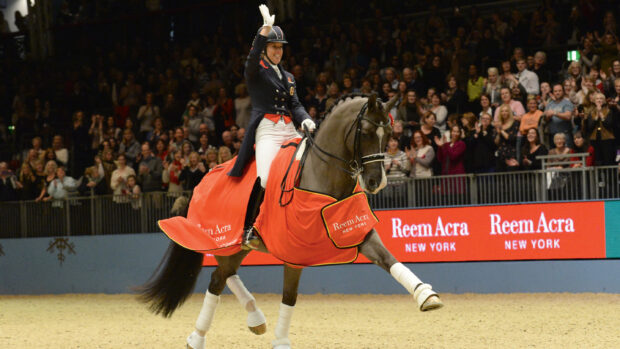International grand prix dressage rider and trainer Anna Ross, who has represented Britain on numerous occasions, shares her thoughts on the dressage at London International and criticism on social media
As someone who tries not to engage with Christmas, I’m delighted that the season of Michael Bublé – unacceptable at any time of the year in my mind – is over. His festive ditties along with whimsical memes featuring talking animals are as traditional to me as the social media trolls who wait for the dressage at the London International Horse Show.
Becky Moody’s test was an absolute blast to watch. A real performance with showstopper music that everyone knew. We all fell in love with Jagerbomb who, although only nine years old, seemed to relish his moment in the spotlight and was lifted by the crowd’s joy in his performance.
I think we have reached the stage where it would be more of a shock if there wasn’t a drama on social media following the dressage but while the online voices appeared intense, the spectator judging, a snapshot of dressage public opinion, was largely in agreement with the international judges, having the first three in the same order.
In training and riding, we are religiously taught to ride the hindleg to the bit. But online, observations on the neck and head position are much more commented on than a hindleg or supple back. The neck is easy to see and measure.
The FEI judges’ directives state: “The head should remain in a steady position, as a rule with the nose line slightly in front of the vertical, with a supple poll as the highest point of the neck.”
But the ambience of the combination, expression and signs of stress can only be observed in close proximity, live – that’s why we need human judges.
Of course, the FEI directives also state a requirement for “engagement of the hindquarters, originating from a lively impulsion transmitted through a supple back.”
The more power there is, the more moments of brilliance there are. But with more power also comes a greater risk of tension. In the real world, as opposed to the virtual one, some combinations meet the criteria beautifully in terms of presenting the nose in front of the vertical and others excel in power, cadence and expression. It’s extremely difficult to do both.
“This could be controversial”
I’ve seen all horses that represented Britain in London untacked and it’s common sense to say that both Everdale and Imhotep conformationally have slightly upright necks that are proportionally shorter in length. This makes it harder for them to present the long frames of the horses with naturally big arched necks.
Both have great power and spring fulfilling another FEI criterion of “life and spirit in the paces”. The challenge for their riders is to shape that energy into something calm, supple, loose and flexible.
It’s the ultimate goal that riders strive for as they lose marks when the frame is compromised. This could be the most controversial statement of the year but, contrary to online opinion, horses do not automatically rebalance themselves into a perfect frame at all times from day one of training.
Laid-back horses tend to be easier to keep out in the neck in a hot environment as they don’t have as much fire coming into the bridle to be rebalanced. Having the nose in front does not automatically mean the horse is engaged and supple. A horse can be in front of the vertical with an uncomfortably dropped back and trailing hindleg.
In the real world, we see plenty of horses at all levels ridden in this way with the riders blissfully unaware that their horse is protecting itself from the rider, raising the neck and poking its head out forming a canoe shape for the riders backside to snuggle into before an evening in front of the laptop with a glass of pinot slating their fellow equestrians.
A new year brings new hopes, dreams and challenges. Not much chance of peace and harmony, and it’s unlikely to be good tidings to all men online. However, I wish all readers all the luck and joy in 2024.
● Do you think that online criticism has gone too far? Write to us at hhletters@futurenet.com, including your name, nearest town and county, for the chance to have your thoughts published in a future edition of Horse & Hound magazine
- This exclusive column will also be available to read in Horse & Hound magazine, in shops from Friday 5 January, 2024
You may also be interested in…

‘It makes me emotional to think what I’ve achieved this year’: Charlotte Dujardin wows en route to London International freestyle victory

‘To ride here is emotional’: Lottie Fry and Everdale dazzle in London International freestyle

‘My horse is an absolute legend’: Becky Moody and Jagerbomb impress on London International debut

Subscribe to Horse & Hound magazine today – and enjoy unlimited website access all year round
Horse & Hound magazine, out every Thursday, is packed with all the latest news and reports, as well as interviews, specials, nostalgia, vet and training advice. Find how you can enjoy the magazine delivered to your door every week, plus options to upgrade your subscription to access our online service that brings you breaking news and reports as well as other benefits.




